Shell Company: HR Department's Role in Change Management Analysis
VerifiedAdded on 2020/03/02
|26
|6081
|85
Report
AI Summary
This report delves into the organizational changes within the Shell Company, highlighting the critical role of the Human Resources (HR) department in facilitating these transformations. It examines change management systems, including the models of change (Unfreeze, Transition, Refreeze) and Kotter's 8-Step Change Model, which are essential for navigating organizational shifts. The report explores the functions of HR professionals as change agents, encompassing roles such as change champions, adapters, consultants, and synergists. It also discusses the significance of organizational changes driven by factors like new technology, mergers, internal and external pressures, government regulations, customer needs, and relationship skills. Through analysis and discussion, the report identifies best practices and offers a comprehensive understanding of how HR contributes to Shell's success in a competitive market.
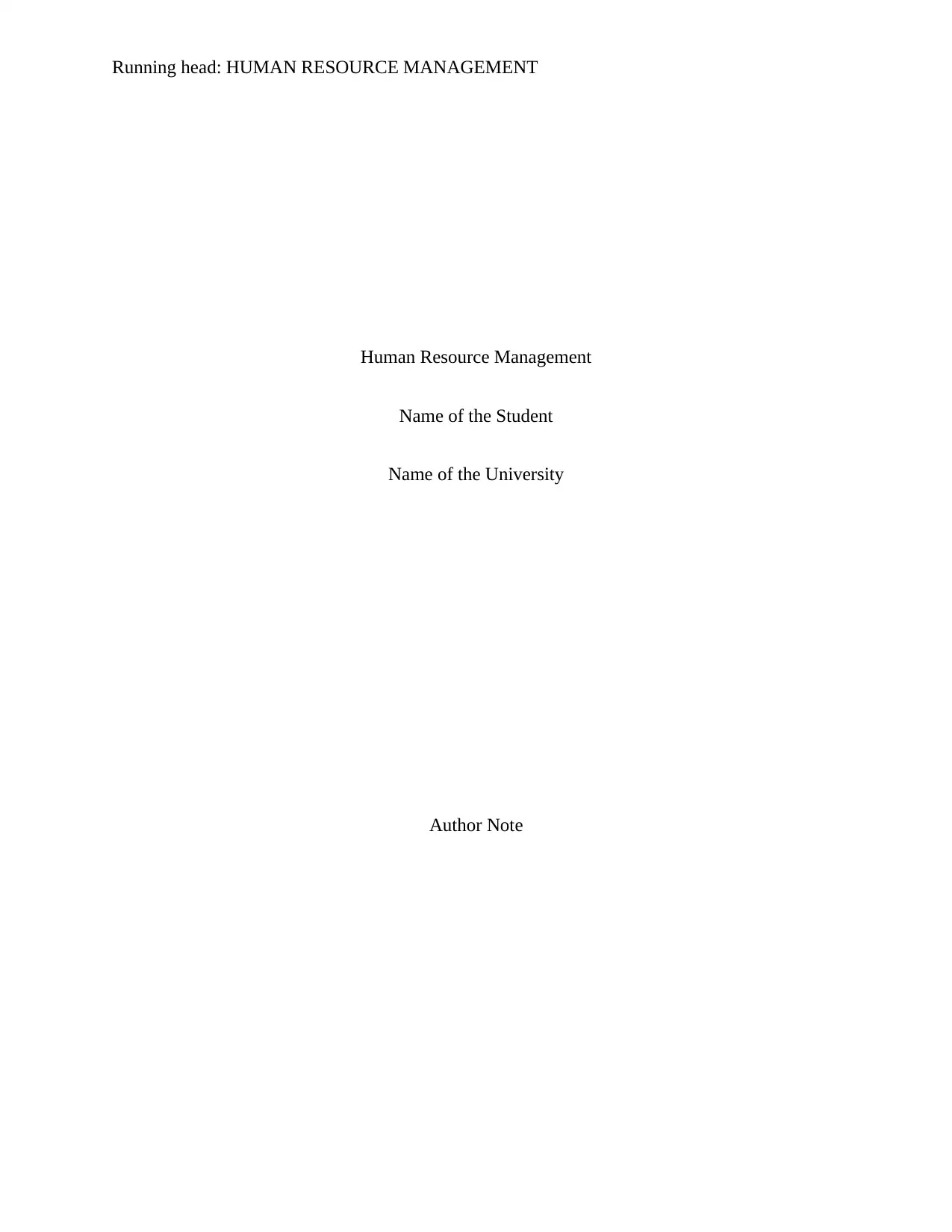
Running head: HUMAN RESOURCE MANAGEMENT
Human Resource Management
Name of the Student
Name of the University
Author Note
Human Resource Management
Name of the Student
Name of the University
Author Note
Paraphrase This Document
Need a fresh take? Get an instant paraphrase of this document with our AI Paraphraser
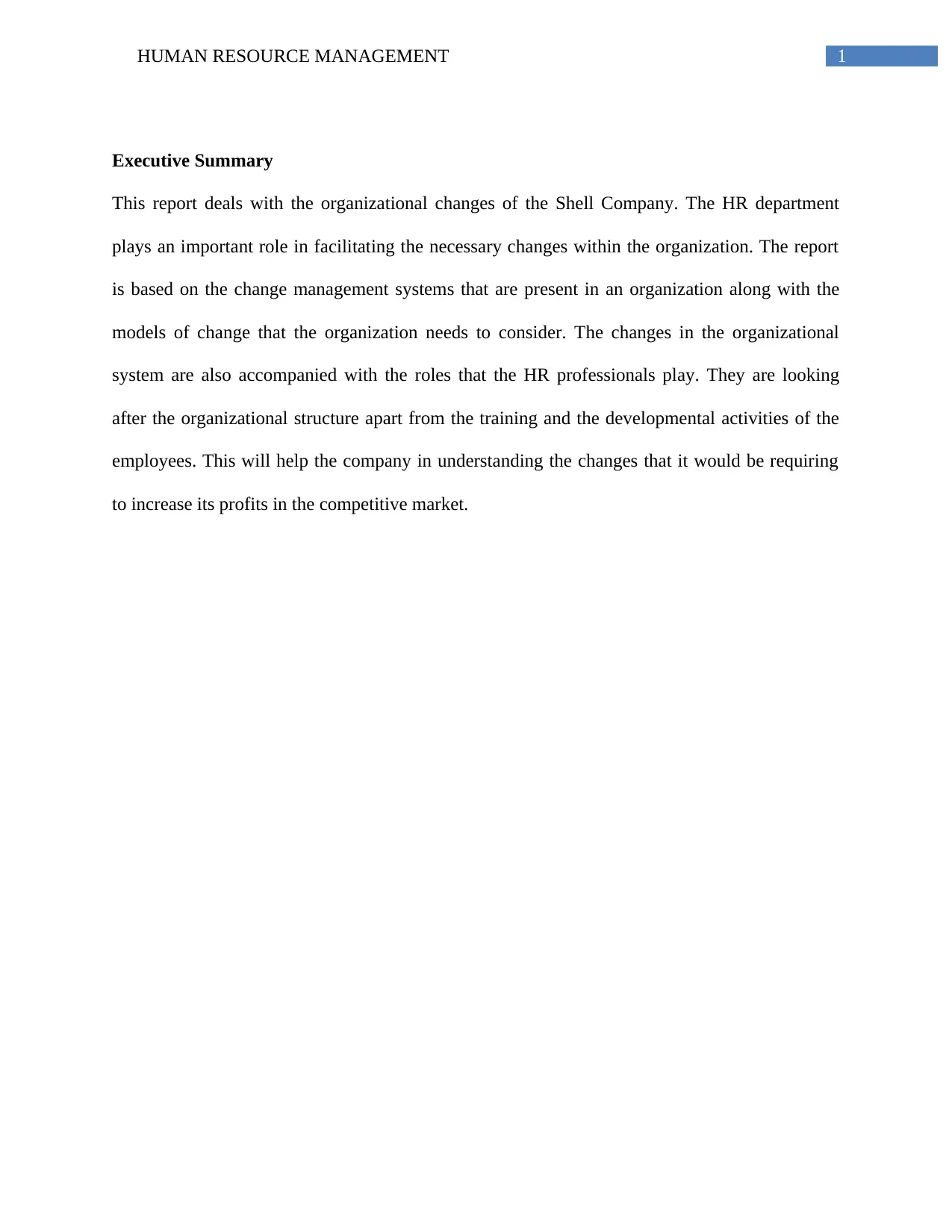
1HUMAN RESOURCE MANAGEMENT
Executive Summary
This report deals with the organizational changes of the Shell Company. The HR department
plays an important role in facilitating the necessary changes within the organization. The report
is based on the change management systems that are present in an organization along with the
models of change that the organization needs to consider. The changes in the organizational
system are also accompanied with the roles that the HR professionals play. They are looking
after the organizational structure apart from the training and the developmental activities of the
employees. This will help the company in understanding the changes that it would be requiring
to increase its profits in the competitive market.
Executive Summary
This report deals with the organizational changes of the Shell Company. The HR department
plays an important role in facilitating the necessary changes within the organization. The report
is based on the change management systems that are present in an organization along with the
models of change that the organization needs to consider. The changes in the organizational
system are also accompanied with the roles that the HR professionals play. They are looking
after the organizational structure apart from the training and the developmental activities of the
employees. This will help the company in understanding the changes that it would be requiring
to increase its profits in the competitive market.
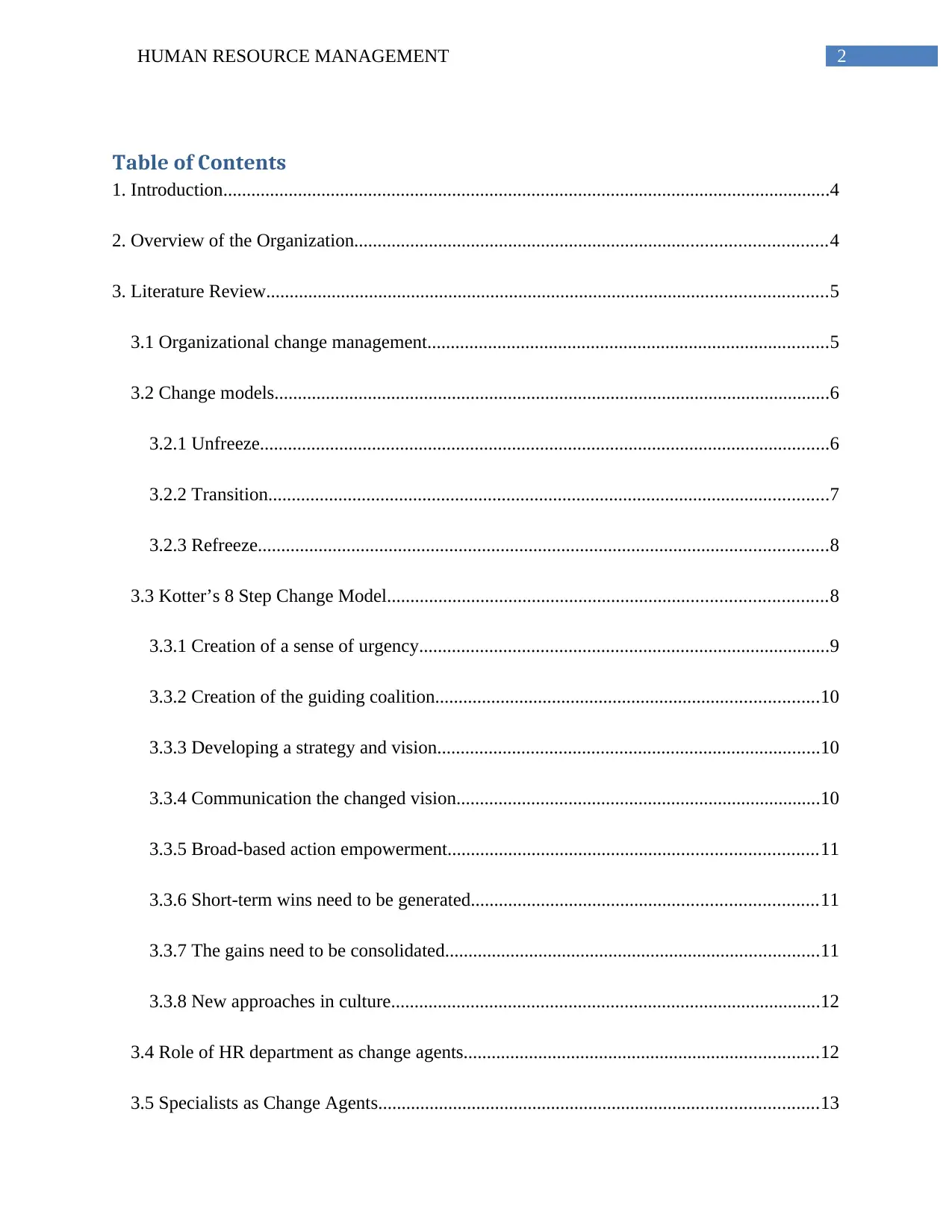
2HUMAN RESOURCE MANAGEMENT
Table of Contents
1. Introduction..................................................................................................................................4
2. Overview of the Organization.....................................................................................................4
3. Literature Review........................................................................................................................5
3.1 Organizational change management......................................................................................5
3.2 Change models.......................................................................................................................6
3.2.1 Unfreeze..........................................................................................................................6
3.2.2 Transition........................................................................................................................7
3.2.3 Refreeze..........................................................................................................................8
3.3 Kotter’s 8 Step Change Model..............................................................................................8
3.3.1 Creation of a sense of urgency........................................................................................9
3.3.2 Creation of the guiding coalition..................................................................................10
3.3.3 Developing a strategy and vision..................................................................................10
3.3.4 Communication the changed vision..............................................................................10
3.3.5 Broad-based action empowerment...............................................................................11
3.3.6 Short-term wins need to be generated..........................................................................11
3.3.7 The gains need to be consolidated................................................................................11
3.3.8 New approaches in culture............................................................................................12
3.4 Role of HR department as change agents............................................................................12
3.5 Specialists as Change Agents..............................................................................................13
Table of Contents
1. Introduction..................................................................................................................................4
2. Overview of the Organization.....................................................................................................4
3. Literature Review........................................................................................................................5
3.1 Organizational change management......................................................................................5
3.2 Change models.......................................................................................................................6
3.2.1 Unfreeze..........................................................................................................................6
3.2.2 Transition........................................................................................................................7
3.2.3 Refreeze..........................................................................................................................8
3.3 Kotter’s 8 Step Change Model..............................................................................................8
3.3.1 Creation of a sense of urgency........................................................................................9
3.3.2 Creation of the guiding coalition..................................................................................10
3.3.3 Developing a strategy and vision..................................................................................10
3.3.4 Communication the changed vision..............................................................................10
3.3.5 Broad-based action empowerment...............................................................................11
3.3.6 Short-term wins need to be generated..........................................................................11
3.3.7 The gains need to be consolidated................................................................................11
3.3.8 New approaches in culture............................................................................................12
3.4 Role of HR department as change agents............................................................................12
3.5 Specialists as Change Agents..............................................................................................13
⊘ This is a preview!⊘
Do you want full access?
Subscribe today to unlock all pages.

Trusted by 1+ million students worldwide
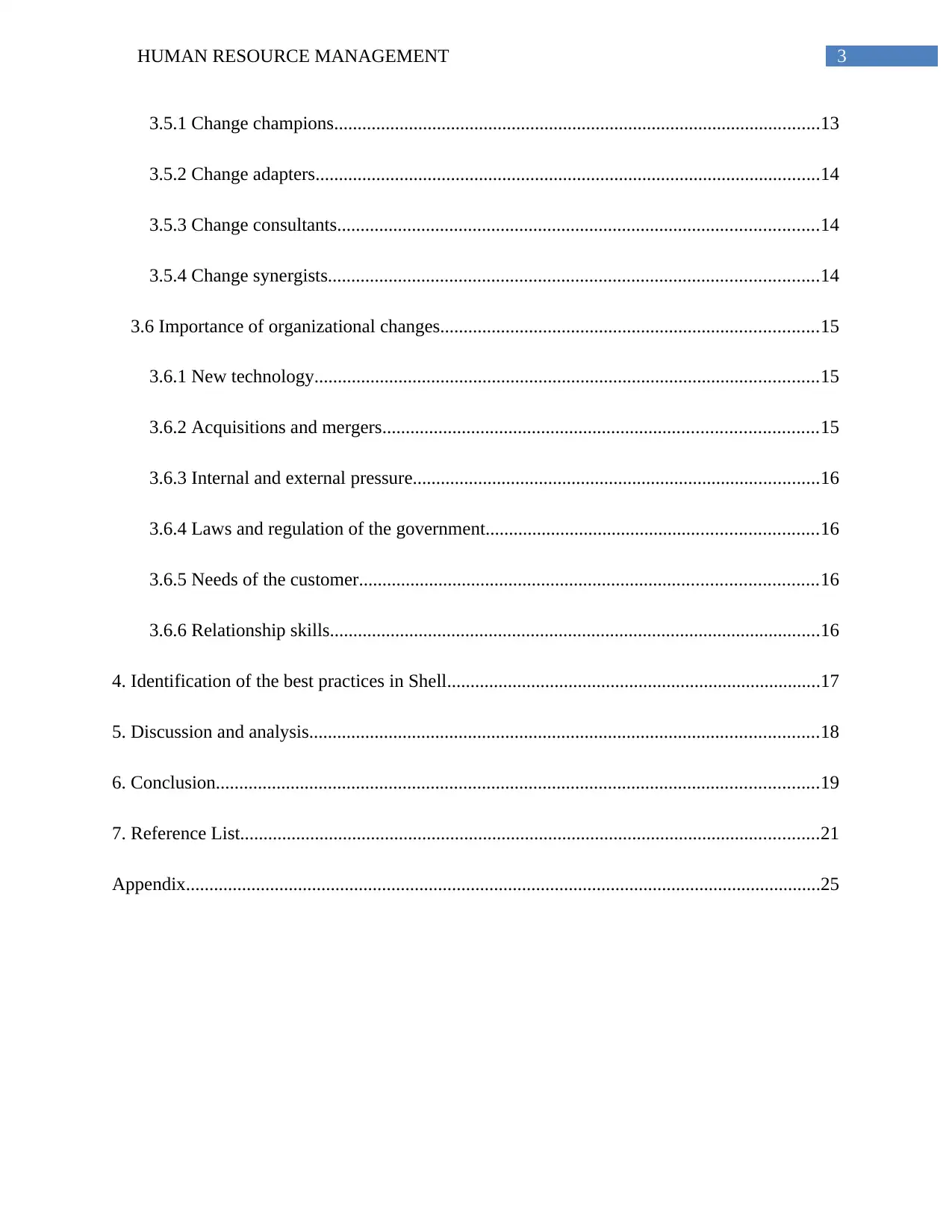
3HUMAN RESOURCE MANAGEMENT
3.5.1 Change champions........................................................................................................13
3.5.2 Change adapters............................................................................................................14
3.5.3 Change consultants.......................................................................................................14
3.5.4 Change synergists.........................................................................................................14
3.6 Importance of organizational changes.................................................................................15
3.6.1 New technology............................................................................................................15
3.6.2 Acquisitions and mergers.............................................................................................15
3.6.3 Internal and external pressure.......................................................................................16
3.6.4 Laws and regulation of the government.......................................................................16
3.6.5 Needs of the customer..................................................................................................16
3.6.6 Relationship skills.........................................................................................................16
4. Identification of the best practices in Shell................................................................................17
5. Discussion and analysis.............................................................................................................18
6. Conclusion.................................................................................................................................19
7. Reference List............................................................................................................................21
Appendix........................................................................................................................................25
3.5.1 Change champions........................................................................................................13
3.5.2 Change adapters............................................................................................................14
3.5.3 Change consultants.......................................................................................................14
3.5.4 Change synergists.........................................................................................................14
3.6 Importance of organizational changes.................................................................................15
3.6.1 New technology............................................................................................................15
3.6.2 Acquisitions and mergers.............................................................................................15
3.6.3 Internal and external pressure.......................................................................................16
3.6.4 Laws and regulation of the government.......................................................................16
3.6.5 Needs of the customer..................................................................................................16
3.6.6 Relationship skills.........................................................................................................16
4. Identification of the best practices in Shell................................................................................17
5. Discussion and analysis.............................................................................................................18
6. Conclusion.................................................................................................................................19
7. Reference List............................................................................................................................21
Appendix........................................................................................................................................25
Paraphrase This Document
Need a fresh take? Get an instant paraphrase of this document with our AI Paraphraser
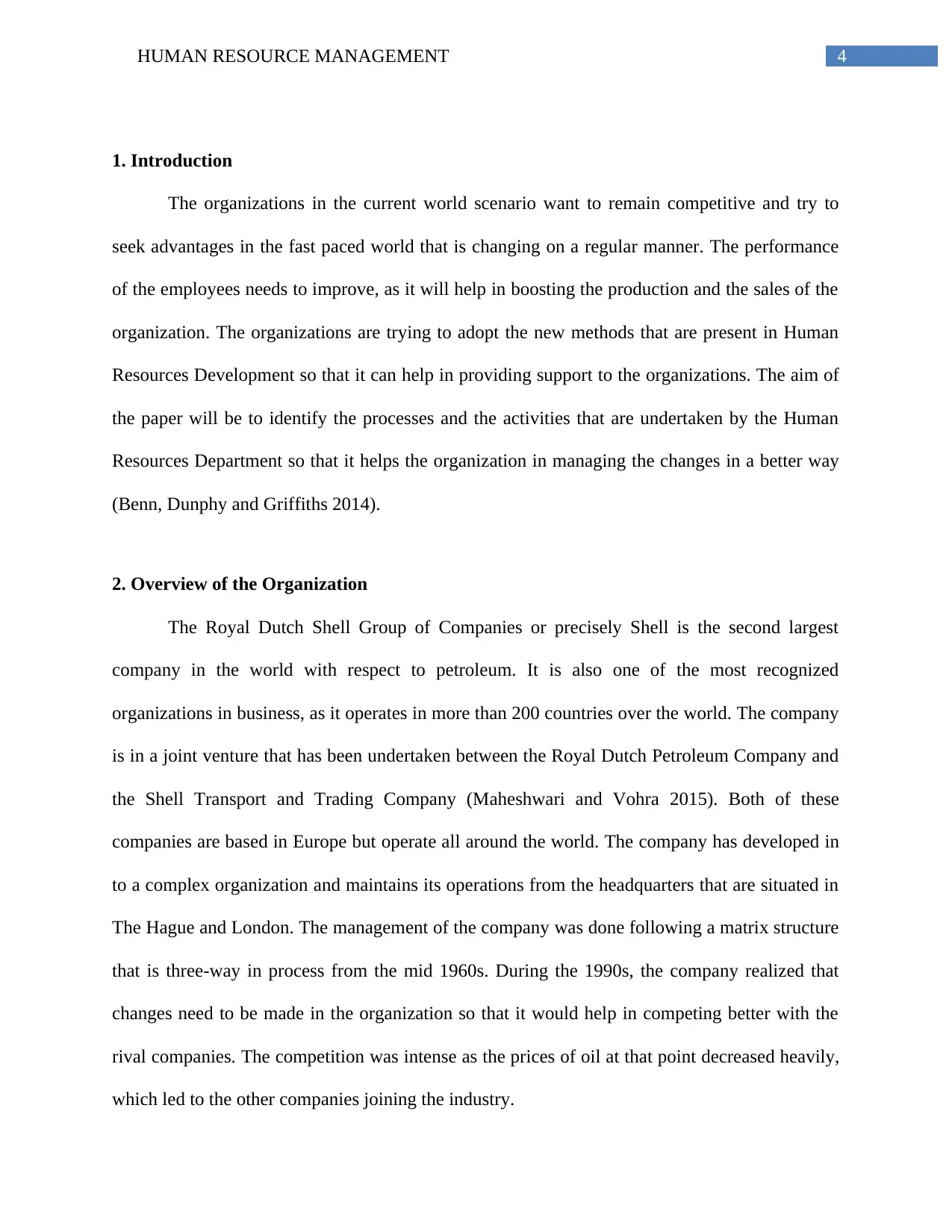
4HUMAN RESOURCE MANAGEMENT
1. Introduction
The organizations in the current world scenario want to remain competitive and try to
seek advantages in the fast paced world that is changing on a regular manner. The performance
of the employees needs to improve, as it will help in boosting the production and the sales of the
organization. The organizations are trying to adopt the new methods that are present in Human
Resources Development so that it can help in providing support to the organizations. The aim of
the paper will be to identify the processes and the activities that are undertaken by the Human
Resources Department so that it helps the organization in managing the changes in a better way
(Benn, Dunphy and Griffiths 2014).
2. Overview of the Organization
The Royal Dutch Shell Group of Companies or precisely Shell is the second largest
company in the world with respect to petroleum. It is also one of the most recognized
organizations in business, as it operates in more than 200 countries over the world. The company
is in a joint venture that has been undertaken between the Royal Dutch Petroleum Company and
the Shell Transport and Trading Company (Maheshwari and Vohra 2015). Both of these
companies are based in Europe but operate all around the world. The company has developed in
to a complex organization and maintains its operations from the headquarters that are situated in
The Hague and London. The management of the company was done following a matrix structure
that is three-way in process from the mid 1960s. During the 1990s, the company realized that
changes need to be made in the organization so that it would help in competing better with the
rival companies. The competition was intense as the prices of oil at that point decreased heavily,
which led to the other companies joining the industry.
1. Introduction
The organizations in the current world scenario want to remain competitive and try to
seek advantages in the fast paced world that is changing on a regular manner. The performance
of the employees needs to improve, as it will help in boosting the production and the sales of the
organization. The organizations are trying to adopt the new methods that are present in Human
Resources Development so that it can help in providing support to the organizations. The aim of
the paper will be to identify the processes and the activities that are undertaken by the Human
Resources Department so that it helps the organization in managing the changes in a better way
(Benn, Dunphy and Griffiths 2014).
2. Overview of the Organization
The Royal Dutch Shell Group of Companies or precisely Shell is the second largest
company in the world with respect to petroleum. It is also one of the most recognized
organizations in business, as it operates in more than 200 countries over the world. The company
is in a joint venture that has been undertaken between the Royal Dutch Petroleum Company and
the Shell Transport and Trading Company (Maheshwari and Vohra 2015). Both of these
companies are based in Europe but operate all around the world. The company has developed in
to a complex organization and maintains its operations from the headquarters that are situated in
The Hague and London. The management of the company was done following a matrix structure
that is three-way in process from the mid 1960s. During the 1990s, the company realized that
changes need to be made in the organization so that it would help in competing better with the
rival companies. The competition was intense as the prices of oil at that point decreased heavily,
which led to the other companies joining the industry.
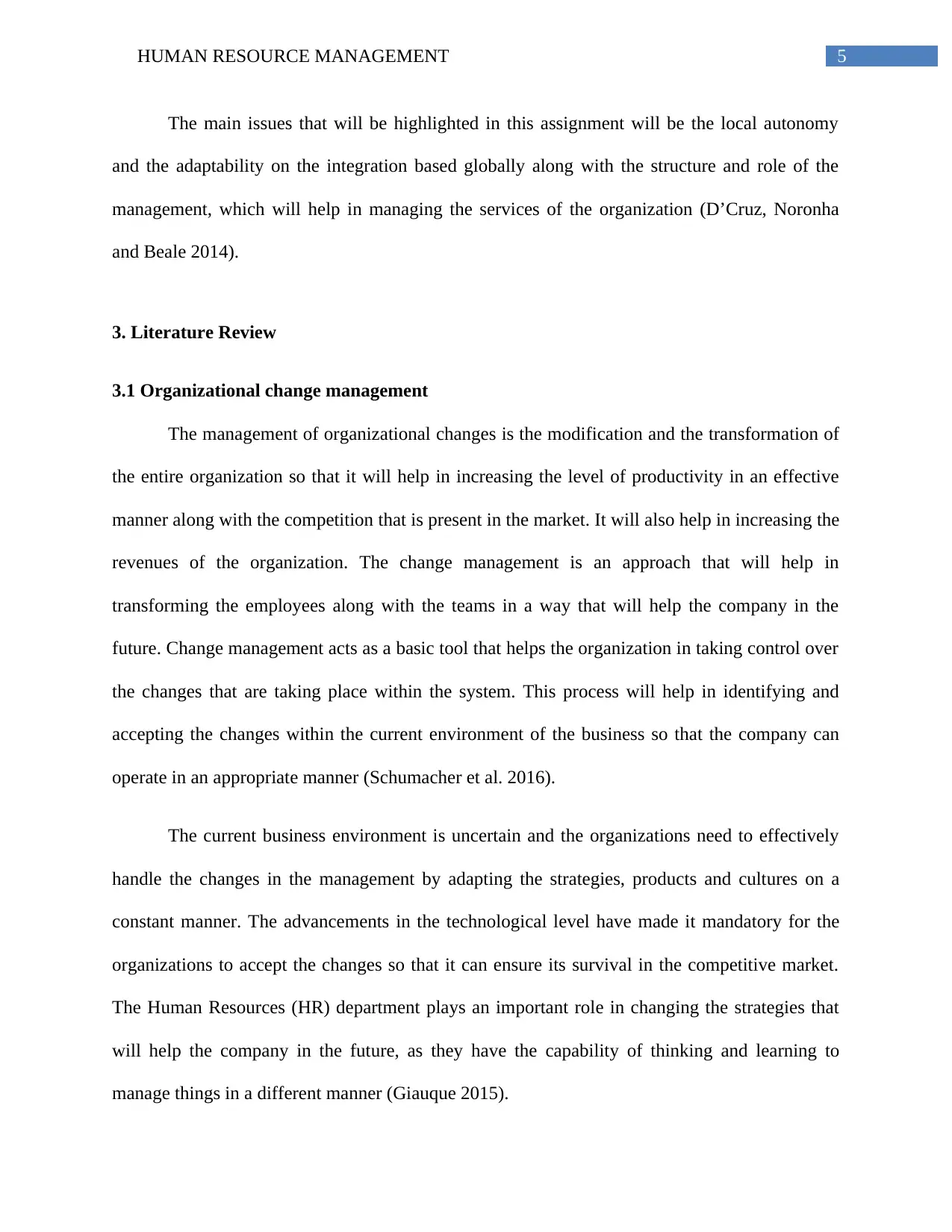
5HUMAN RESOURCE MANAGEMENT
The main issues that will be highlighted in this assignment will be the local autonomy
and the adaptability on the integration based globally along with the structure and role of the
management, which will help in managing the services of the organization (D’Cruz, Noronha
and Beale 2014).
3. Literature Review
3.1 Organizational change management
The management of organizational changes is the modification and the transformation of
the entire organization so that it will help in increasing the level of productivity in an effective
manner along with the competition that is present in the market. It will also help in increasing the
revenues of the organization. The change management is an approach that will help in
transforming the employees along with the teams in a way that will help the company in the
future. Change management acts as a basic tool that helps the organization in taking control over
the changes that are taking place within the system. This process will help in identifying and
accepting the changes within the current environment of the business so that the company can
operate in an appropriate manner (Schumacher et al. 2016).
The current business environment is uncertain and the organizations need to effectively
handle the changes in the management by adapting the strategies, products and cultures on a
constant manner. The advancements in the technological level have made it mandatory for the
organizations to accept the changes so that it can ensure its survival in the competitive market.
The Human Resources (HR) department plays an important role in changing the strategies that
will help the company in the future, as they have the capability of thinking and learning to
manage things in a different manner (Giauque 2015).
The main issues that will be highlighted in this assignment will be the local autonomy
and the adaptability on the integration based globally along with the structure and role of the
management, which will help in managing the services of the organization (D’Cruz, Noronha
and Beale 2014).
3. Literature Review
3.1 Organizational change management
The management of organizational changes is the modification and the transformation of
the entire organization so that it will help in increasing the level of productivity in an effective
manner along with the competition that is present in the market. It will also help in increasing the
revenues of the organization. The change management is an approach that will help in
transforming the employees along with the teams in a way that will help the company in the
future. Change management acts as a basic tool that helps the organization in taking control over
the changes that are taking place within the system. This process will help in identifying and
accepting the changes within the current environment of the business so that the company can
operate in an appropriate manner (Schumacher et al. 2016).
The current business environment is uncertain and the organizations need to effectively
handle the changes in the management by adapting the strategies, products and cultures on a
constant manner. The advancements in the technological level have made it mandatory for the
organizations to accept the changes so that it can ensure its survival in the competitive market.
The Human Resources (HR) department plays an important role in changing the strategies that
will help the company in the future, as they have the capability of thinking and learning to
manage things in a different manner (Giauque 2015).
⊘ This is a preview!⊘
Do you want full access?
Subscribe today to unlock all pages.

Trusted by 1+ million students worldwide
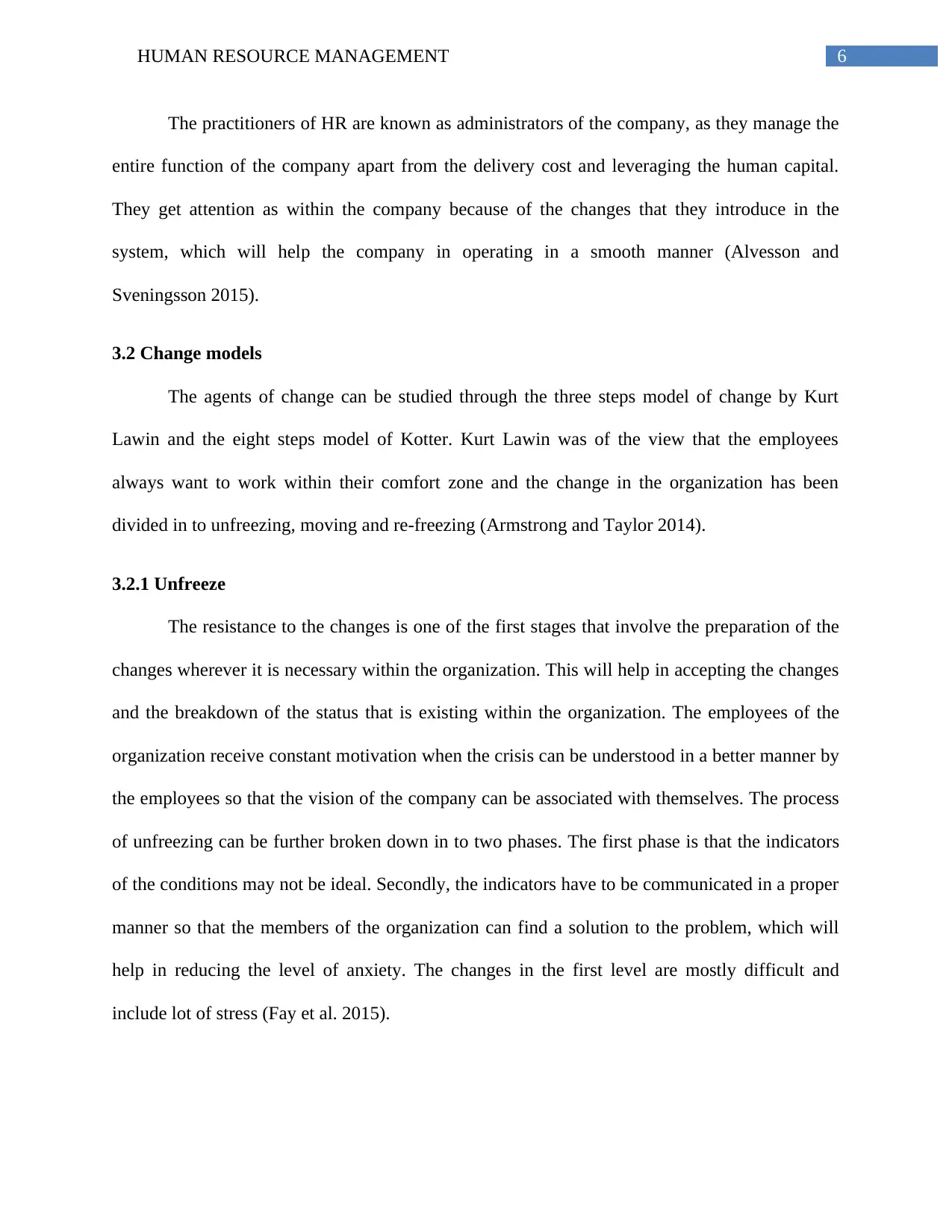
6HUMAN RESOURCE MANAGEMENT
The practitioners of HR are known as administrators of the company, as they manage the
entire function of the company apart from the delivery cost and leveraging the human capital.
They get attention as within the company because of the changes that they introduce in the
system, which will help the company in operating in a smooth manner (Alvesson and
Sveningsson 2015).
3.2 Change models
The agents of change can be studied through the three steps model of change by Kurt
Lawin and the eight steps model of Kotter. Kurt Lawin was of the view that the employees
always want to work within their comfort zone and the change in the organization has been
divided in to unfreezing, moving and re-freezing (Armstrong and Taylor 2014).
3.2.1 Unfreeze
The resistance to the changes is one of the first stages that involve the preparation of the
changes wherever it is necessary within the organization. This will help in accepting the changes
and the breakdown of the status that is existing within the organization. The employees of the
organization receive constant motivation when the crisis can be understood in a better manner by
the employees so that the vision of the company can be associated with themselves. The process
of unfreezing can be further broken down in to two phases. The first phase is that the indicators
of the conditions may not be ideal. Secondly, the indicators have to be communicated in a proper
manner so that the members of the organization can find a solution to the problem, which will
help in reducing the level of anxiety. The changes in the first level are mostly difficult and
include lot of stress (Fay et al. 2015).
The practitioners of HR are known as administrators of the company, as they manage the
entire function of the company apart from the delivery cost and leveraging the human capital.
They get attention as within the company because of the changes that they introduce in the
system, which will help the company in operating in a smooth manner (Alvesson and
Sveningsson 2015).
3.2 Change models
The agents of change can be studied through the three steps model of change by Kurt
Lawin and the eight steps model of Kotter. Kurt Lawin was of the view that the employees
always want to work within their comfort zone and the change in the organization has been
divided in to unfreezing, moving and re-freezing (Armstrong and Taylor 2014).
3.2.1 Unfreeze
The resistance to the changes is one of the first stages that involve the preparation of the
changes wherever it is necessary within the organization. This will help in accepting the changes
and the breakdown of the status that is existing within the organization. The employees of the
organization receive constant motivation when the crisis can be understood in a better manner by
the employees so that the vision of the company can be associated with themselves. The process
of unfreezing can be further broken down in to two phases. The first phase is that the indicators
of the conditions may not be ideal. Secondly, the indicators have to be communicated in a proper
manner so that the members of the organization can find a solution to the problem, which will
help in reducing the level of anxiety. The changes in the first level are mostly difficult and
include lot of stress (Fay et al. 2015).
Paraphrase This Document
Need a fresh take? Get an instant paraphrase of this document with our AI Paraphraser
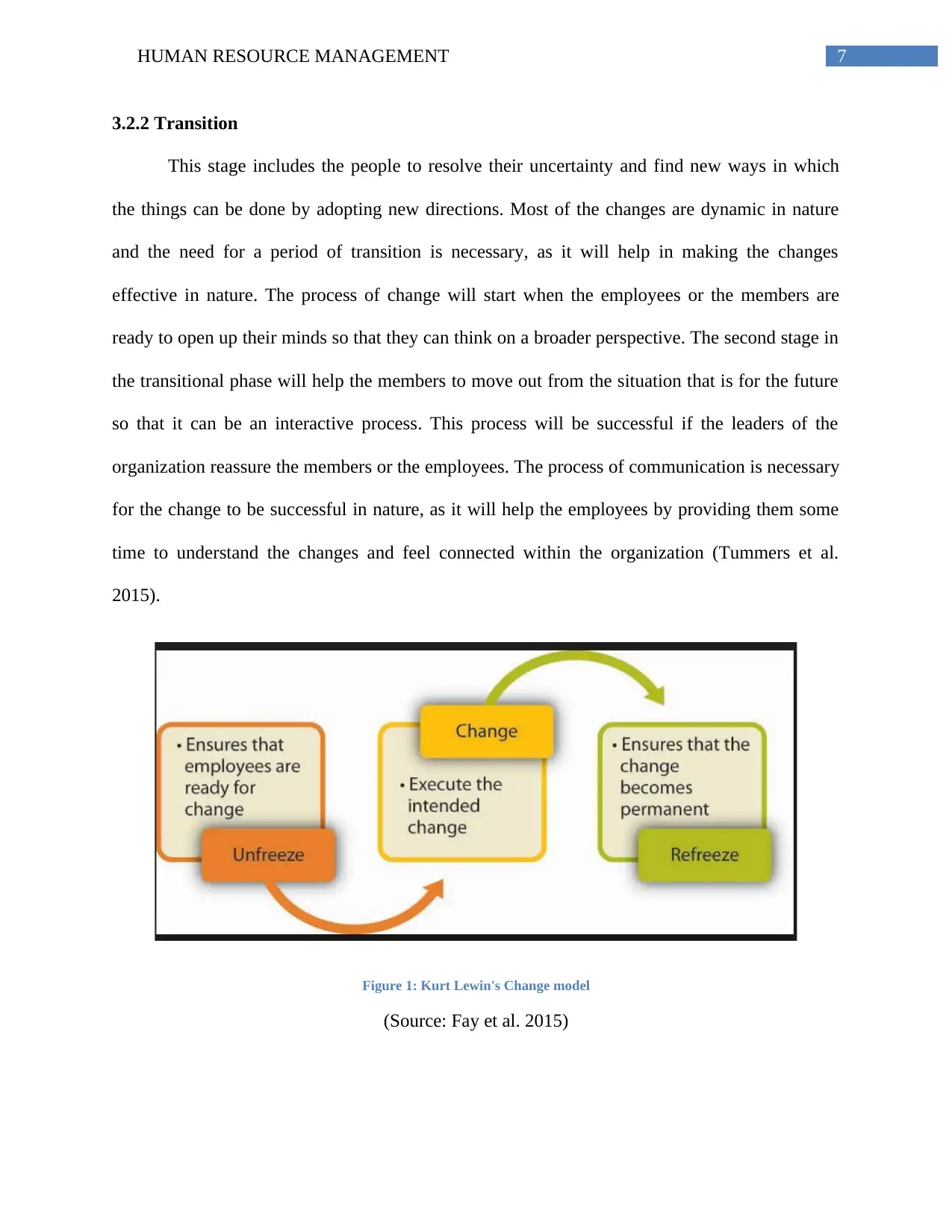
7HUMAN RESOURCE MANAGEMENT
3.2.2 Transition
This stage includes the people to resolve their uncertainty and find new ways in which
the things can be done by adopting new directions. Most of the changes are dynamic in nature
and the need for a period of transition is necessary, as it will help in making the changes
effective in nature. The process of change will start when the employees or the members are
ready to open up their minds so that they can think on a broader perspective. The second stage in
the transitional phase will help the members to move out from the situation that is for the future
so that it can be an interactive process. This process will be successful if the leaders of the
organization reassure the members or the employees. The process of communication is necessary
for the change to be successful in nature, as it will help the employees by providing them some
time to understand the changes and feel connected within the organization (Tummers et al.
2015).
Figure 1: Kurt Lewin's Change model
(Source: Fay et al. 2015)
3.2.2 Transition
This stage includes the people to resolve their uncertainty and find new ways in which
the things can be done by adopting new directions. Most of the changes are dynamic in nature
and the need for a period of transition is necessary, as it will help in making the changes
effective in nature. The process of change will start when the employees or the members are
ready to open up their minds so that they can think on a broader perspective. The second stage in
the transitional phase will help the members to move out from the situation that is for the future
so that it can be an interactive process. This process will be successful if the leaders of the
organization reassure the members or the employees. The process of communication is necessary
for the change to be successful in nature, as it will help the employees by providing them some
time to understand the changes and feel connected within the organization (Tummers et al.
2015).
Figure 1: Kurt Lewin's Change model
(Source: Fay et al. 2015)
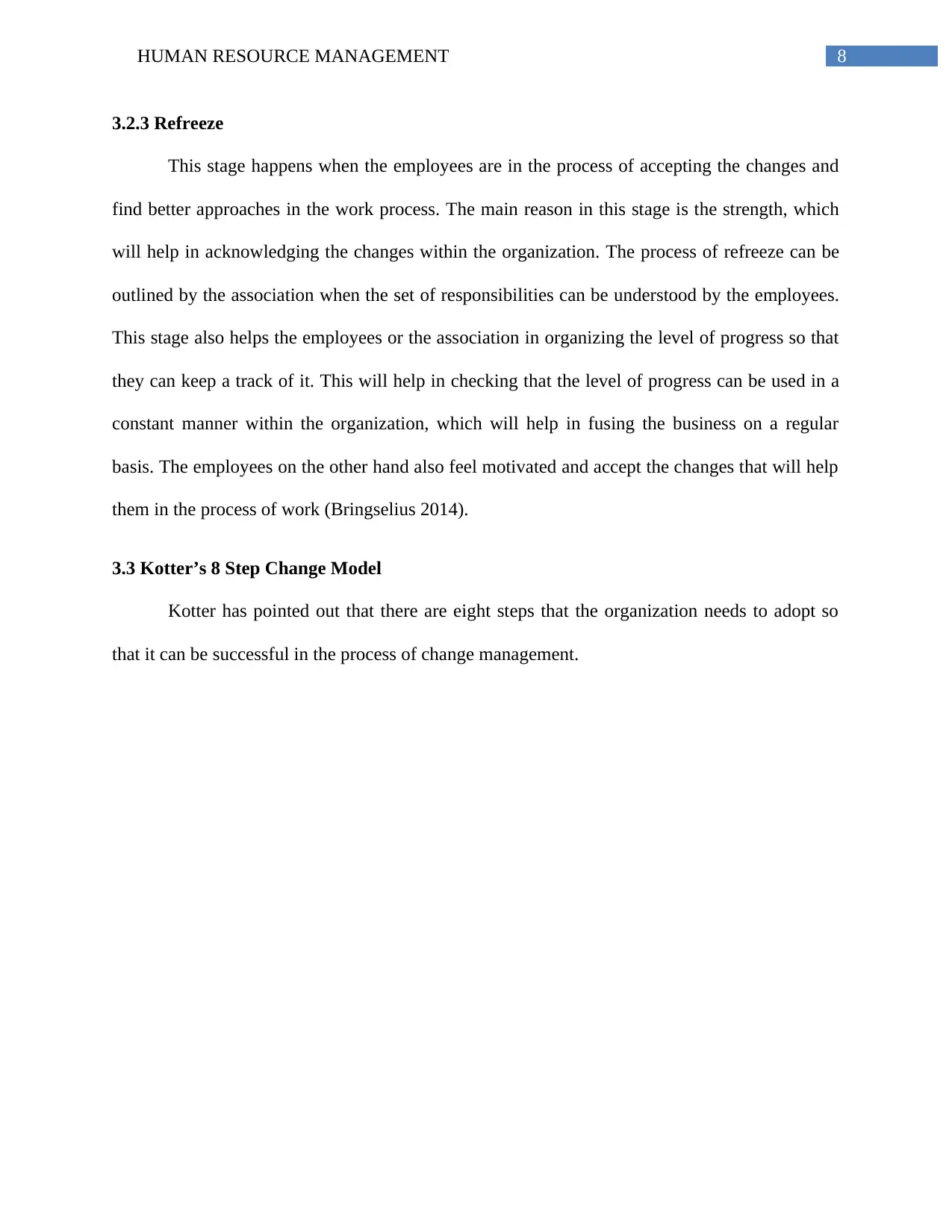
8HUMAN RESOURCE MANAGEMENT
3.2.3 Refreeze
This stage happens when the employees are in the process of accepting the changes and
find better approaches in the work process. The main reason in this stage is the strength, which
will help in acknowledging the changes within the organization. The process of refreeze can be
outlined by the association when the set of responsibilities can be understood by the employees.
This stage also helps the employees or the association in organizing the level of progress so that
they can keep a track of it. This will help in checking that the level of progress can be used in a
constant manner within the organization, which will help in fusing the business on a regular
basis. The employees on the other hand also feel motivated and accept the changes that will help
them in the process of work (Bringselius 2014).
3.3 Kotter’s 8 Step Change Model
Kotter has pointed out that there are eight steps that the organization needs to adopt so
that it can be successful in the process of change management.
3.2.3 Refreeze
This stage happens when the employees are in the process of accepting the changes and
find better approaches in the work process. The main reason in this stage is the strength, which
will help in acknowledging the changes within the organization. The process of refreeze can be
outlined by the association when the set of responsibilities can be understood by the employees.
This stage also helps the employees or the association in organizing the level of progress so that
they can keep a track of it. This will help in checking that the level of progress can be used in a
constant manner within the organization, which will help in fusing the business on a regular
basis. The employees on the other hand also feel motivated and accept the changes that will help
them in the process of work (Bringselius 2014).
3.3 Kotter’s 8 Step Change Model
Kotter has pointed out that there are eight steps that the organization needs to adopt so
that it can be successful in the process of change management.
⊘ This is a preview!⊘
Do you want full access?
Subscribe today to unlock all pages.

Trusted by 1+ million students worldwide
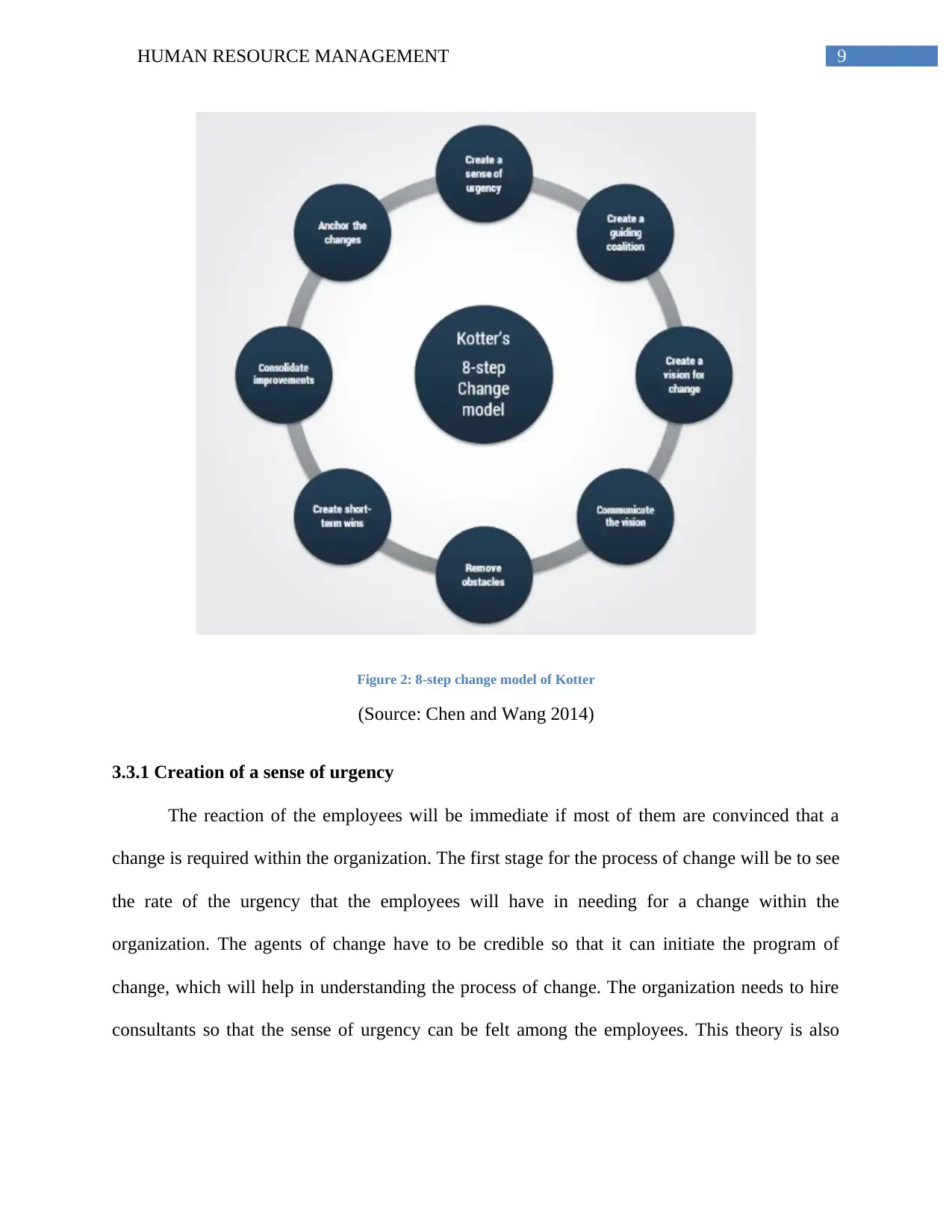
9HUMAN RESOURCE MANAGEMENT
Figure 2: 8-step change model of Kotter
(Source: Chen and Wang 2014)
3.3.1 Creation of a sense of urgency
The reaction of the employees will be immediate if most of them are convinced that a
change is required within the organization. The first stage for the process of change will be to see
the rate of the urgency that the employees will have in needing for a change within the
organization. The agents of change have to be credible so that it can initiate the program of
change, which will help in understanding the process of change. The organization needs to hire
consultants so that the sense of urgency can be felt among the employees. This theory is also
Figure 2: 8-step change model of Kotter
(Source: Chen and Wang 2014)
3.3.1 Creation of a sense of urgency
The reaction of the employees will be immediate if most of them are convinced that a
change is required within the organization. The first stage for the process of change will be to see
the rate of the urgency that the employees will have in needing for a change within the
organization. The agents of change have to be credible so that it can initiate the program of
change, which will help in understanding the process of change. The organization needs to hire
consultants so that the sense of urgency can be felt among the employees. This theory is also
Paraphrase This Document
Need a fresh take? Get an instant paraphrase of this document with our AI Paraphraser
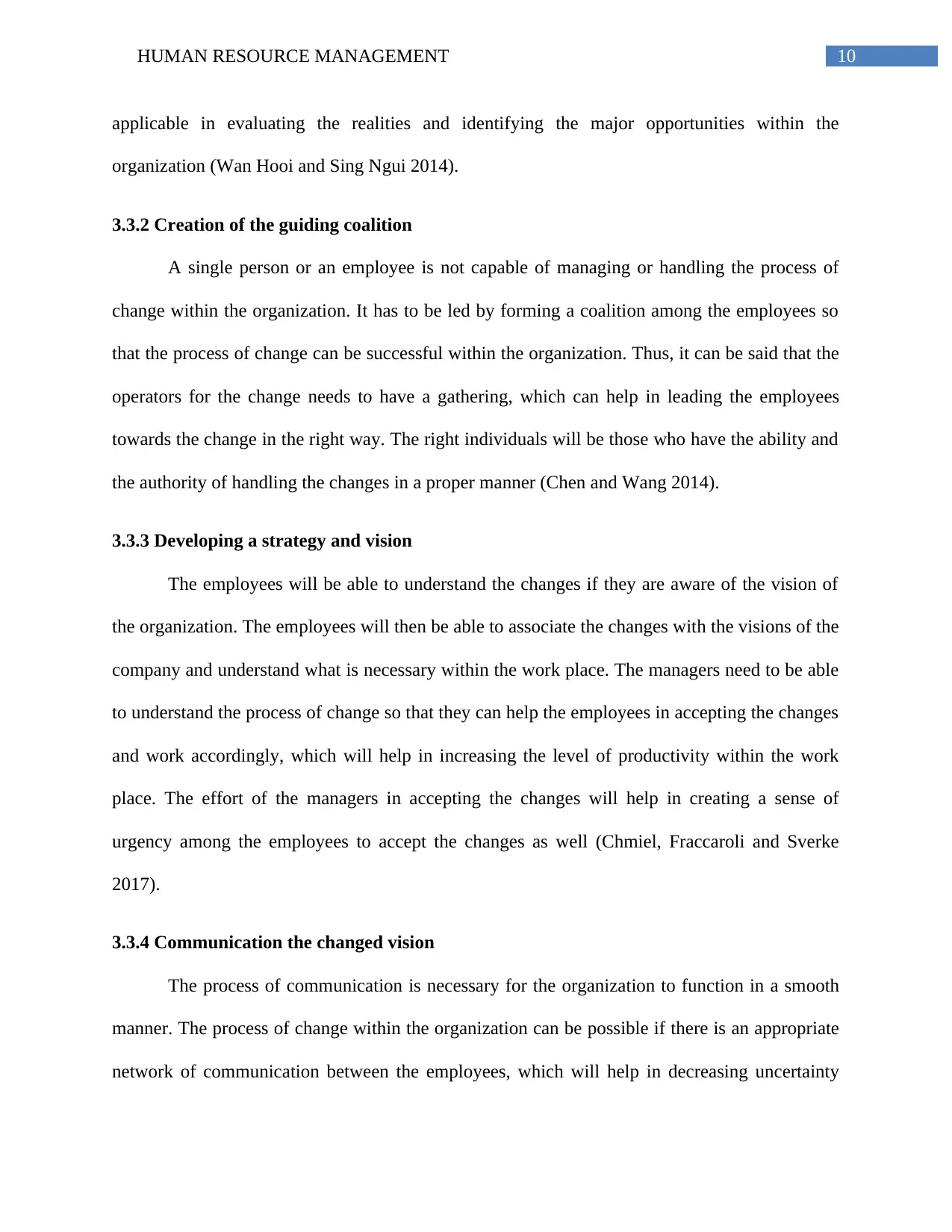
10HUMAN RESOURCE MANAGEMENT
applicable in evaluating the realities and identifying the major opportunities within the
organization (Wan Hooi and Sing Ngui 2014).
3.3.2 Creation of the guiding coalition
A single person or an employee is not capable of managing or handling the process of
change within the organization. It has to be led by forming a coalition among the employees so
that the process of change can be successful within the organization. Thus, it can be said that the
operators for the change needs to have a gathering, which can help in leading the employees
towards the change in the right way. The right individuals will be those who have the ability and
the authority of handling the changes in a proper manner (Chen and Wang 2014).
3.3.3 Developing a strategy and vision
The employees will be able to understand the changes if they are aware of the vision of
the organization. The employees will then be able to associate the changes with the visions of the
company and understand what is necessary within the work place. The managers need to be able
to understand the process of change so that they can help the employees in accepting the changes
and work accordingly, which will help in increasing the level of productivity within the work
place. The effort of the managers in accepting the changes will help in creating a sense of
urgency among the employees to accept the changes as well (Chmiel, Fraccaroli and Sverke
2017).
3.3.4 Communication the changed vision
The process of communication is necessary for the organization to function in a smooth
manner. The process of change within the organization can be possible if there is an appropriate
network of communication between the employees, which will help in decreasing uncertainty
applicable in evaluating the realities and identifying the major opportunities within the
organization (Wan Hooi and Sing Ngui 2014).
3.3.2 Creation of the guiding coalition
A single person or an employee is not capable of managing or handling the process of
change within the organization. It has to be led by forming a coalition among the employees so
that the process of change can be successful within the organization. Thus, it can be said that the
operators for the change needs to have a gathering, which can help in leading the employees
towards the change in the right way. The right individuals will be those who have the ability and
the authority of handling the changes in a proper manner (Chen and Wang 2014).
3.3.3 Developing a strategy and vision
The employees will be able to understand the changes if they are aware of the vision of
the organization. The employees will then be able to associate the changes with the visions of the
company and understand what is necessary within the work place. The managers need to be able
to understand the process of change so that they can help the employees in accepting the changes
and work accordingly, which will help in increasing the level of productivity within the work
place. The effort of the managers in accepting the changes will help in creating a sense of
urgency among the employees to accept the changes as well (Chmiel, Fraccaroli and Sverke
2017).
3.3.4 Communication the changed vision
The process of communication is necessary for the organization to function in a smooth
manner. The process of change within the organization can be possible if there is an appropriate
network of communication between the employees, which will help in decreasing uncertainty
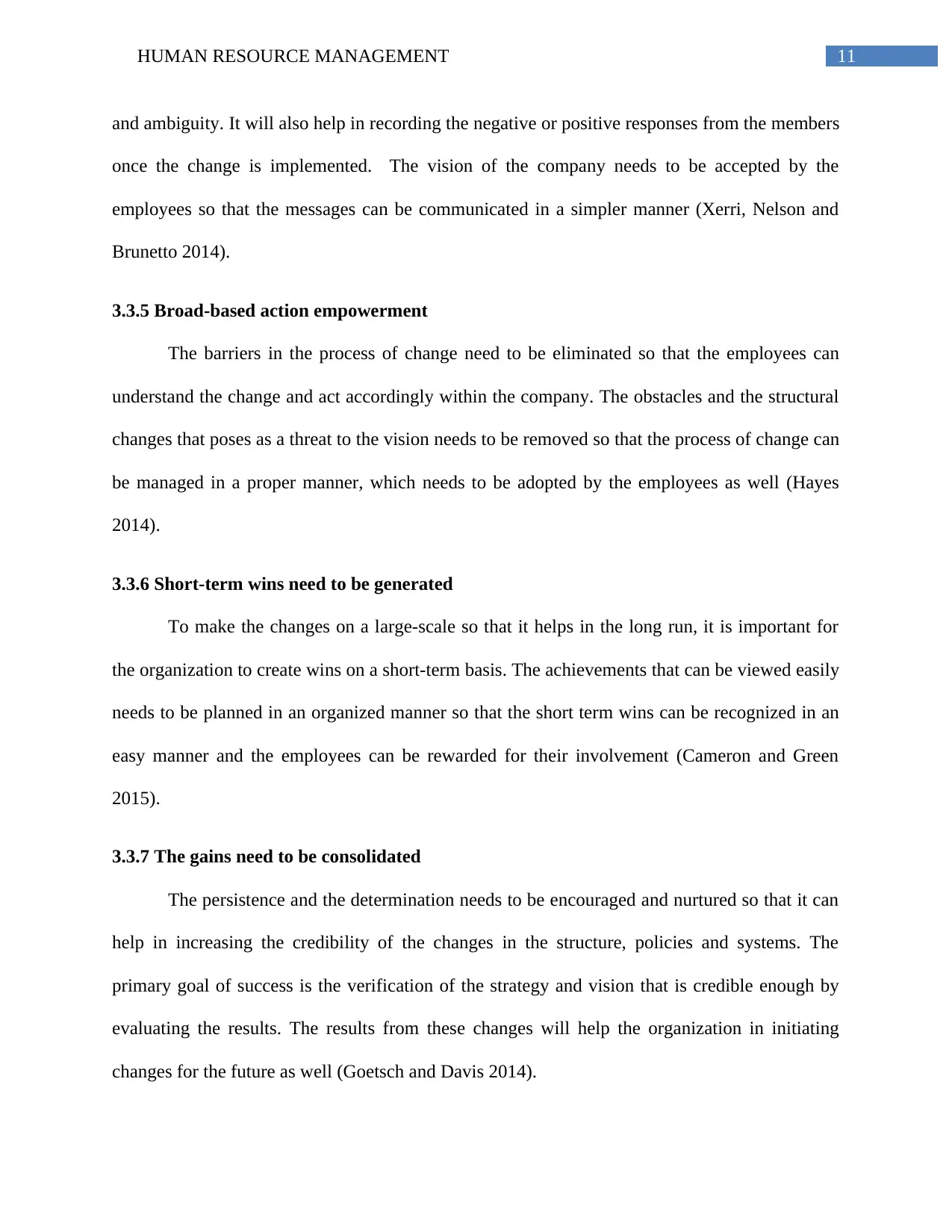
11HUMAN RESOURCE MANAGEMENT
and ambiguity. It will also help in recording the negative or positive responses from the members
once the change is implemented. The vision of the company needs to be accepted by the
employees so that the messages can be communicated in a simpler manner (Xerri, Nelson and
Brunetto 2014).
3.3.5 Broad-based action empowerment
The barriers in the process of change need to be eliminated so that the employees can
understand the change and act accordingly within the company. The obstacles and the structural
changes that poses as a threat to the vision needs to be removed so that the process of change can
be managed in a proper manner, which needs to be adopted by the employees as well (Hayes
2014).
3.3.6 Short-term wins need to be generated
To make the changes on a large-scale so that it helps in the long run, it is important for
the organization to create wins on a short-term basis. The achievements that can be viewed easily
needs to be planned in an organized manner so that the short term wins can be recognized in an
easy manner and the employees can be rewarded for their involvement (Cameron and Green
2015).
3.3.7 The gains need to be consolidated
The persistence and the determination needs to be encouraged and nurtured so that it can
help in increasing the credibility of the changes in the structure, policies and systems. The
primary goal of success is the verification of the strategy and vision that is credible enough by
evaluating the results. The results from these changes will help the organization in initiating
changes for the future as well (Goetsch and Davis 2014).
and ambiguity. It will also help in recording the negative or positive responses from the members
once the change is implemented. The vision of the company needs to be accepted by the
employees so that the messages can be communicated in a simpler manner (Xerri, Nelson and
Brunetto 2014).
3.3.5 Broad-based action empowerment
The barriers in the process of change need to be eliminated so that the employees can
understand the change and act accordingly within the company. The obstacles and the structural
changes that poses as a threat to the vision needs to be removed so that the process of change can
be managed in a proper manner, which needs to be adopted by the employees as well (Hayes
2014).
3.3.6 Short-term wins need to be generated
To make the changes on a large-scale so that it helps in the long run, it is important for
the organization to create wins on a short-term basis. The achievements that can be viewed easily
needs to be planned in an organized manner so that the short term wins can be recognized in an
easy manner and the employees can be rewarded for their involvement (Cameron and Green
2015).
3.3.7 The gains need to be consolidated
The persistence and the determination needs to be encouraged and nurtured so that it can
help in increasing the credibility of the changes in the structure, policies and systems. The
primary goal of success is the verification of the strategy and vision that is credible enough by
evaluating the results. The results from these changes will help the organization in initiating
changes for the future as well (Goetsch and Davis 2014).
⊘ This is a preview!⊘
Do you want full access?
Subscribe today to unlock all pages.

Trusted by 1+ million students worldwide
1 out of 26
Related Documents
Your All-in-One AI-Powered Toolkit for Academic Success.
+13062052269
info@desklib.com
Available 24*7 on WhatsApp / Email
![[object Object]](/_next/static/media/star-bottom.7253800d.svg)
Unlock your academic potential
Copyright © 2020–2025 A2Z Services. All Rights Reserved. Developed and managed by ZUCOL.




